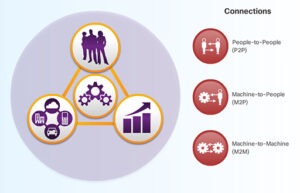Red flags of a Toxic Hybrid Workplace
In the modern work landscape, the hybrid workplace model is increasingly becoming the norm, offering the flexibility and convenience of balancing in-office and remote work. While this model boasts several advantages, it also brings unique challenges. When these challenges are not effectively addressed, it can spiral into creating a toxic hybrid workplace. In this article, we’ll dive deep into understanding the red flags of a toxic hybrid workplace and provide strategies to navigate such an environment effectively.

What is Hybrid Workplace
Definition of a Hybrid Workplace
A hybrid workplace is a model that combines remote work with office work. Employees have the flexibility to work from home some days and come into the office on other days. This arrangement provides the balance between remote work’s flexibility and in-person collaboration’s effectiveness.
Benefits of a Hybrid Workplace
Hybrid workplaces provide numerous benefits. Employees have the flexibility to choose their work environments, which can lead to increased productivity, job satisfaction, and work-life balance. For employers, it can lead to reduced overhead costs, expanded talent pools, and increased employee retention.
Potential Challenges in a Hybrid Workplace
However, like any other model, a hybrid workplace can also have challenges. These may include communication difficulties, discrepancies in work-life balance, and potential feelings of isolation or disconnectedness among remote employees.
The Toxic Hybrid Workplace
Definition of a Toxic Workplace
A toxic workplace is a work environment characterized by unhealthy behaviors and attitudes, negatively affecting employees’ well-being and productivity. When these characteristics infiltrate a hybrid workplace, they create a toxic hybrid workplace that can be harmful to both remote and in-office employees.
Recognizing the Symptoms of a Toxic Hybrid Workplace
Recognizing the signs of a toxic hybrid workplace is crucial for maintaining employee well-being. Symptoms may include a constant feeling of dread about work, high levels of stress, a lack of support from management, and a culture of blame rather than learning from mistakes.
Red Flags in a Toxic Hybrid Workplace
Lack of Clear Communication
A significant red flag in a toxic hybrid workplace is poor communication. This could mean unclear instructions, lack of feedback, or information being shared unevenly among staff. In a hybrid model, it’s even more crucial to have clear, open lines of communication to bridge the gap between in-office and remote employees.
Excessive Workload and Unbalanced Work-life Balance
Another red flag is an excessive workload leading to an unbalanced work-life balance. With the line between work and home blurred in a hybrid model, employees might be expected to be always “on,” leading to stress, burnout, and reduced productivity.
Unsupportive Management
Unsupportive management can significantly contribute to a toxic hybrid workplace. If managers are not responsive, dismissive of concerns, or favor in-office employees over remote ones, it creates an unfair, toxic environment.
Employee Burnout and High Turnover Rate
High employee turnover rates and burnout are also strong indicators of a toxic workplace. If employees frequently leave or express feelings of extreme exhaustion, disillusionment, and frustration, it might be a sign that the work environment is harmful.
No Room for Professional Growth
Lack of opportunities for career advancement or professional growth is another significant red flag. If employees feel stuck in their roles with no chance of promotion or improvement, it can lead to dissatisfaction and decreased motivation.
Navigating a Toxic Hybrid Workplace
Maintaining Mental Well-being
Maintaining mental well-being is crucial in a toxic environment. This might include practicing mindfulness, seeking therapeutic support, or finding healthy ways to unwind and de-stress.
Setting Boundaries
Setting boundaries between work and personal life is essential, particularly in a hybrid model. This might mean setting specific work hours and sticking to them or having a designated workspace at home.
Seeking Support
Seeking support, whether from colleagues, HR, or external networks, can be beneficial. Sharing experiences and strategies can help employees feel less alone and more equipped to handle the situation.
Considering a Change
Finally, if the toxicity level is too high and affecting one’s health and well-being, it might be time to consider a change. This could mean seeking a new role within the company, finding a new job elsewhere, or even discussing the issues with higher management or HR to seek a resolution.
FAQs About Hybrid Workplace
What is a hybrid workplace?
A hybrid workplace is a model that combines remote work with office work, providing flexibility for employees to work from both home and office.
What are some red flags of a toxic hybrid workplace?
Red flags include lack of clear communication, excessive workload, unsupportive management, high employee turnover rates, and lack of professional growth opportunities.
How can I navigate a toxic hybrid workplace?
Strategies include maintaining mental well-being, setting boundaries, seeking support, and considering a change if necessary.
How does a toxic hybrid workplace affect employees?
It can lead to high levels of stress, burnout, decreased motivation, and reduced job satisfaction and productivity.
What can management do to prevent a toxic hybrid workplace?
Management can foster open communication, provide support, ensure fair workloads, and provide opportunities for professional growth.
Conclusion
A toxic hybrid workplace is harmful and can seriously affect an employee’s mental and physical health, productivity, and overall job satisfaction. Recognizing the red flags and knowing how to navigate such a situation can help employees protect their well-being and maintain their career trajectory.













Post Comment